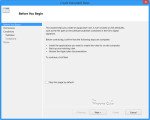
I added the deny rules explicitly because the default rules weren't working. Below is a screenshot of the current policy.

The policy still didn't work after restarting. It was at that point I did more googling, and saw that the App Identity service had to be running, and it wasn't: So, like any good admin, I started it, set it to automatic, and rebooted just in case.
Disable applocker windows 7 download#
After deploying this policy and verifying it was being applied to the correct user using gpresult, I was still able to download and run an exe from the internet, an exe that was saved to the user profile's temp folder. Per Microsoft's technet article on the subject, any files not explicitly allowed to run by the policy are supposed to be blocked from running. appidtel.exe stop Īll of these steps can be run on a single machine or deployed as a script to multiple devices.I've setup a basic group policy consisting of the default Applocker rules. Run the following PowerShell commands to stop the AppLocker services and change their startup configuration. Then run the following command from an elevated PowerShell session to remove all local AppLocker policies from the device: C:\Users\Administrator> Set-AppLockerPolicy -XMLPolicy $env:USERPROFILE\Desktop\clear.xml To clear AppLocker policies on a single system or remote systemsįirst import the AppLocker modules for PowerShell: PS C:\Users\Administrator> import-module AppLockerĬreate a file called clear.xml with the following XML content and save it to your desktop. When the following procedure is performed on the local device, the AppLocker policy takes effect immediately. If the Application Identity service is stopped before deleting Applocker rules, and if Applocker blocks apps that are disabled, delete all of the files at C:\Windows\System32\AppLocker. If you disable Applocker and delete Applocker rules, make sure to stop the Application Identity service after deleting Applocker rules. Application Identity service needs to be running for deleting Applocker rules.When using Group Policy, the Group Policy Object must be distributed or refreshed for rule deletion to take effect on devices.In the details pane, right-click the rule to delete, select Delete, and then select Yes.Select the appropriate rule collection for which you want to delete the rule.Any AppLocker policies delivered through MDM or Group Policy must be removed using those tools. These steps apply only for locally managed devices.
Disable applocker windows 7 how to#
For info how to use these MMC snap-ins to administer AppLocker, see Administer AppLocker. You can perform this task by using the Group Policy Management Console for an AppLocker policy in a Group Policy Object (GPO) or by using the Local Security Policy snap-in for an AppLocker policy on a local computer or in a security template. If an app is no longer supported by your organization, then deleting the rule or rules associated with that app prevents the app from running.įor info about testing an AppLocker policy to see what rules affect which files or applications, see Test an AppLocker policy by Using Test-AppLockerPolicy. This article for IT professionals describes the steps to delete AppLocker rules.Īs older apps are retired and new apps are deployed in your organization, it's necessary to modify the application control policies. Learn more about the Windows Defender Application Control feature availability.

Some capabilities of Windows Defender Application Control are only available on specific Windows versions.


 0 kommentar(er)
0 kommentar(er)
